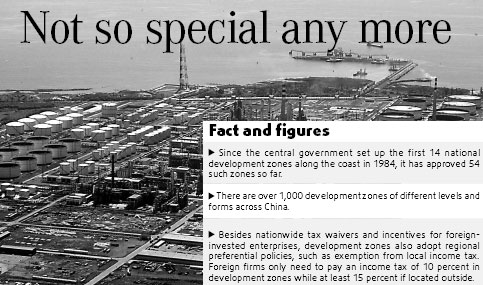Not so special any more
Updated: 2007-09-06 06:26

Storm clouds are gathering over the famed development zones as these centerpieces of China's spectacular economic growth begin to recede from the center of policymakers' attention.
New economic policies pose new challenges for these hubs that churn out about 10 percent of the country's total industrial output, 15 percent of exports and about a quarter of realized foreign direct investment, robbing them of the policy advantages once bestowed upon them to power national growth.
The first challenge comes from the new corporate income tax, which takes effect next year. The new system will not only unify tax rates for domestic and foreign enterprises but also deprive development zones of the preferential taxes they have come to enjoy.
For example, foreign firms located inside these zones only pay an income tax of 10 percent but at least 15 percent if located outside.
The second setback comes in the shape of land-use restrictions. Earlier, if development zones needed more agricultural land to expand, all they needed to do was apply to the government for permission, which was seldom turned down. But others weren't allowed the same facility.
All that's going to change as the central government has now imposed strict restrictions on industrial land expansion, putting development zones on a par with their lesser cousins.
The way out
Apart from their advanced services and well-oiled infrastructure, the biggest advantage of development zones is their increasing orientation toward industry clusters, says Liu Peiqiang, chairman of China Association of Development Zones.
He sees this as the best way to help eliminate bottlenecks such as the unified tax rates and curbs on land use.
"Development zones have realized that they can no longer fall back on unlimited land expansion and favorable government policies. So industry clustering and strengthening industrial chains should be the focus," Liu says. This view is shared by a number of industry experts.
Many development zones used to rely on far too favorable policies to attract foreign investors, says He Manqing, with the research institute of the Ministry of Commerce.
"They should now say 'no' to energy-intensive and highly polluting projects," she says.
Meng Xianchang, an official with the Liaocheng Development Zone in East China's Shandong Province, says the zone has become picky in the kind of investment it wants to attract, selecting only the companies that fit the existing clusters. "Projects related to our major sectors will get priority," he says.
These days the zone mainly focuses on five major industrial chains: food, textile, machinery, steel and information technology.
"In a specific sector, we will boost leading enterprises and stretch the industrial chain upward and downward," Meng says.
The government is encouraging foreign investors to concentrate on hi-tech industries and advanced manufacturing in development zones, according to Li Zhiqun, director of the Commerce Ministry's foreign investment administration department.
But as the policy gap for ventures inside and outside the zones narrow, "some zones have prepared for the changes", says Liu of the China Association of Development Zones.
Some zones, he says, see the curbs on land use as an opportunity to streamline their units by cutting down on the less productive operations. "Now they factor in the restrictions and allocate land to only those enterprises that help them optimize the existing industry clusters."
Some, like the Kunshan Development Zone in East China's Jiangsu Province, had actually anticipated the introduction of land-use restrictions and tailored their allotments accordingly as far back as 2002.
"Our land-use growth decreased by 50 percent each year [since], but output continued to grow robustly," says an official with the development zone who refuses to be named.
But even though the Kunshan zone has, for years, made it a policy to select projects that eat up minimum land, it still feels the pinch of land shortage. It has thus called on enterprises deemed at odds with its long-term strategy, such as labor-intensive units, to move out.
So far, Kunshan Development Zone has persuaded 30 to 40 labor-intensive enterprises to leave when their contracts expire. To help them find a new location, in 2004 Kushan joined forces with Lianyungang, a city 500 kilometers away.
Even among the new investors, the ones Kunshan found inconsistent with its goals were persuaded to settle for Lianyugang. Ten such enterprises have set up shop in Lianyungang.
"We couldn't convince as many enterprises we thought we would because some of them came to us for the industrial advantages of the Yangtze River Delta," says the Kunshan official. "But we believe this is the way to go."
Regional balance
The restructuring in the advanced zones made imminent by the policy changes has had one very positive macroeconomic effect: it has benefited the less developed regions, which have been lapping up the projects driven from or rejected by the advanced zones.
Finding no takers in the established industrial zones, foreign investors have been forced to locate in Central and Western China, says Liu.
The Ministry of Commerce has also been encouraging this redrawing of the industrial map. In March, it held a "project-matching event" in Guangzhou Province, in which each development zone in East China presented two to three enterprises ready to locate in the development zones of West and Central China.
The ministry and the China Development Bank have also lined up loans of up to 15 billion yuan to be distributed in the next five years on infrastructure of national and some key provincial development zones in the western and central regions respectively. The ministry has also pledged to support these zones with infrastructure and labor training.
As they say, every cloud has a silver lining.
(China Daily 09/06/2007 page45)
|
|
|
||
|
||
|
|
|
|